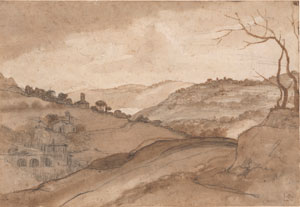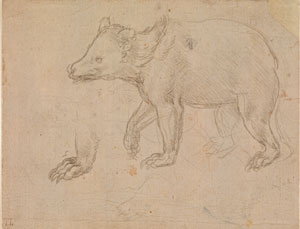Gentlemen and Giants
John Haberin New York City
Poussin, Claude, and French Drawing
The Lehman Collection: From Leonardo to Matisse
Before you get too far into French drawing at the Morgan Library, you might stop to compare two striking examples on facing walls. If you think of the Baroque as high drama or ornate, they seem to set you alone with their subjects. If you think of classical as academic, the Royal Academy was still years away.
All that makes for insights and wonders. So does a focus on the development of a century and a style. A more diffuse show, like that of the Thaw collection also at the Morgan, can do only so much apart from acknowledging or flattering a patron— even with so many stunning and representative works on paper from Andrea Mantegna in the Renaissance to Jackson Pollock. The limits are all the clearer at the Met. Robert Lehman had a fondness for copycats. Yet he made them the strength of his drawing collection.
even with so many stunning and representative works on paper from Andrea Mantegna in the Renaissance to Jackson Pollock. The limits are all the clearer at the Met. Robert Lehman had a fondness for copycats. Yet he made them the strength of his drawing collection.
Neither ornate nor academic
Pencil outlines by Jacques Bellange at the Morgan barely contain his brown ink washes and the paper's creamy whites, as they alternate freely down the page. Nor can they quite contain the blinded giant leaning on his cane—or the goddess on his shoulder, leaning down to offer him a smile, a hand, and a guide. They might extend to you as well. Just a turn of the head away, Daniel Dumonstier uses four colors of chalk for the portrait of a gentleman. They bring clarity to the arc of an eyelid, the glint of an eye, the pursed lips, the bridge of his nose, and the points of his mustache and goatee. They also bring a high flourish to every curl of his hair and fold of his ruff collar.
"Poussin, Claude, and French Drawing in the Classical Age" is an overflowing study in contrasts. You can see the erudition of artists and audiences familiar with Ovid's Metamorphoses, poetry, and myth—and sharp eyes concerned for nature and appearances. You can see competing bases for art in Versailles, the royal palace at Fontainebleau that so interested Pablo Picasso, and the ducal court of Lorraine, at Nancy. You can see the growing importance of drawing as central to an artist's working methods and as finished product—for patronage, for sale, for mounting in albums, or for production in series. Dumonstier had a reputation for his four-chalk technique and for entertaining his sitters while he worked. You can see why he was in demand.
Think of them not as conflicting impulses or as tensions within the art. Think of them rather as the nexus of beliefs and practices that define the high style of the 1600s. Throw in the devotion of French Catholics—and try not to worry that the Inquisition had Sébastien Bourdon, a Protestant, on the run. This was the Grand Siècle, or great century, for both royal power and the Baroque. It drew on Italy, from Caravaggio to Gian Lorenzo Bernini, even before the king recalled Simon Vouet to France in 1627. Overwhelmed with commissions and intrigues at the French court, Nicolas Poussin hightailed it back to Rome in 1642 as fast as he could.
The Frick went into greater depth fifteen years ago, with loans from the École des Beaux-Arts in Paris. (Pardon me if I leave a fuller and more helpful look to my review then.) The Morgan has turned to the same century with "Rembrandt's World" in 2012—and to later French drawing with "Fragonard and the French Tradition" in 2006, "Rococo to Revolution" in 2008, and Théodore Rousseau and the Barbizon school in 2014. Here the curators, Jennifer Tonkovich and Marco Simone Bolzoni, trace the influence of the court, the birth of a print culture, and a budding market in collectors (like Johann Wolfgang von Goethe more than a century later). They end with the consolidation of artistic practice in the Academy and the royal collection under Charles Le Brun. Fewer than fifty drawings, almost all from the Morgan's collection, make a compact introduction.
As the show's title suggests, they give the most space to Nicolas Poussin and Claude Gellée, better known as Claude Lorrain. Nowhere else is the mix of classicism, piety, observation, and creativity more apparent. With Poussin's Death of Hippolytes from 1645, real horses run wild past a crag, a mythic chariot overturns, and a tidy pyramid collapses with them. In his study soon after for The Holy Family on the Steps, black chalk adds stabs of insight, and shadows are a torrent of ink and wash. Anne and the infant Saint John have a greater activity than in the painting, and such props as a towel and plant life have not yet given way to its eerie perspective. Claude lends Apollo with a herd of goats both a greater naturalism and a higher polish, while the crossing diagonals of hills, clouds, houses, and trees take on both a greater depth and a supernatural energy.
Claude may have worked from the view out his studio window in Rome or on the spot, only to enhance clouds and reflected sunlight later on. An artist known only as Lagneau may have sketched a peasant's raised hair and crooked mouth, much as August Sander sought social and psychological archetypes in the twentieth century—or he may have posed a workshop assistant and added his imagination. Charles Mellin definitely played with actual and trompe l'oeil architecture in designing a fresco over an arch. Building on a The Visitation by Pontormo from 1528, Laurent de la Hyre allows Mary and Elizabeth a very human warmth, but also a Renaissance bulk and a perfect balance. Earlier, Vouet treats Louis XIII informally, but also apart from details of clothing that might make him a mere mortal. Gentlemen, too, might be giants.
A fondness for copycats
In his fondness for the copyist, Robert Lehman often had little choice. What do you think was on the market when the banker sought out drawings from as early as the Renaissance, building on his father's collection, if not "workshop of" names you are more likely to know? Yet he also liked them for something only a student then could have—the sheer polish of work with an eye to others already finished. One thinks of sketches as an artist's first thoughts, but they are also a discipline. Pinpricks along the outlines could mark their transfer to a painting, or they could stem from dependency on another drawing, one that the master had made available as a model. Such demanding media as metalpoint could indicate an independent drawing for connoisseurs or just more of a test.
Even the unknown artists in a selection of sixty drawings had to be fast learners. Italian drawings and Renaissance drawings could pull off a sense of mass and motion after Lorenzo Monaco around 1420—or the detail in a head by Domenico Ghirlandaio after 1495 that might almost be someone you know. Lehman, though, preferred fast learners when he came to the big names, too, all the way (as the show's title has it) from "Leonardo to Matisse." Rembrandt did not copy The Last Supper, which he never traveled to see, but he did copy a print after Leonardo.  His red chalk unites the apostles in a rapid-fire line of gestures and emotions, with Jesus framed not by a window, but rather by a tapestry with folds that add to the action. When the spontaneous and incomplete finally turns up, with a mountain pass by Fra Bartolomeo around 1500, it comes as a shock.
His red chalk unites the apostles in a rapid-fire line of gestures and emotions, with Jesus framed not by a window, but rather by a tapestry with folds that add to the action. When the spontaneous and incomplete finally turns up, with a mountain pass by Fra Bartolomeo around 1500, it comes as a shock.
Leonardo da Vinci was a famously fast learner—with a contribution to The Baptism of Christ, around 1475, so unified and alive that his teacher, Andrea del Verrocchio, was said to have given up painting after seeing it. Here he turns to nature for a bear walking. A light tracing behind the bear's rear legs suggests a stop-action motion study, while an additional paw with claws only accentuates the sketchy vitality of the rest. Albrecht Dürer was another prodigy, long before his many brilliant prints and sometimes stiff mature paintings. The raised hand in a self-portrait from 1493 presses thumb and two fingers together as not just virtuoso anatomy, but also the assertion that an artist's grip matters. A pillow in front of him boasts of his grasp of solid form and ephemeral shadows.
Dürer continues on the back with six more pillow studies. The Met speaks of the texture of everyday objects, but they look barely textured and anything but mundane. Think instead of a twenty-something punching the pillow again and again to alter its geometry, with a satisfying bam each time. Vincent van Gogh, in contrast, was a slow learner, but an early landscape looks self-assured. Others would have found fault with the wispy figures and the perspective that broadens unnaturally in the foreground. Yet the lone man sweeping leaves and the broadening create a sense of mystery along with a sense of home, and the trees and their shadows to either side measure it out with precision.
Lehman preferred an old-fashioned finish when one least expects it. Henri Matisse has not yet flattened the nude in 1923, and Camille Corot had not yet abandoned the crisp house fronts and still crisper light of his visit to Rome in 1825. Naturally the collector gravitates to Martin Schongauer, the accomplished late Renaissance printmaker, and naturally he takes Pierre-Auguste Renoir and Renoir drawings , with a robust and colorful young woman, as his sole Impressionist. Naturally, too, he likes a model posing for Georges Seurat, the warped Neoclassicism of young Spartans by Edgar Degas, and the three-chalk technique of Jean Antoine Watteau. Still, he found room for a study by Antonio Pollaiuolo for a preposterous equestrian monument, in which a petty dictator would have crushed the nude victim that supports him—and with a dreamer by Jean Honoré Fragonard casting not her reflection in a mirror but her shadow. He also allows J. A. D. Ingres last-minute corrections in white, as if the sitter had cut himself shaving.
Lehman's collecting got him on the Met's board by 1960 and a whole wing to himself in 1975. With luck, a museum will never again make that the terms of a gift, especially when the wing impedes on Central Park. Even now, drawings from no particular place or time can illuminate only so much, and luck is running out when it comes to museum expansions at the expense of budgets and the public. Shoveling Chairs, from the circle of Rogier van der Weyden in the Northern Renaissance, refers to a proverbial expression for a peasant revolution. Still, it forms a tidy arch, and the shovelers look ahead a century to the coarser types of Pieter Bruegel. Money talks, even if revolution is in the air.

French Baroque drawing ran at The Morgan Library through October 15, 2017. Drawings from the Thaw collection ran at the Morgan and drawings from the Lehman collection at The Metropolitan Museum of Art, both through January 7, 2018.




